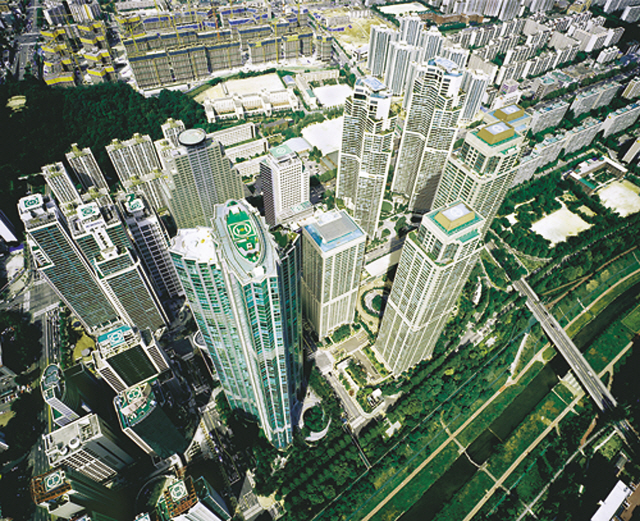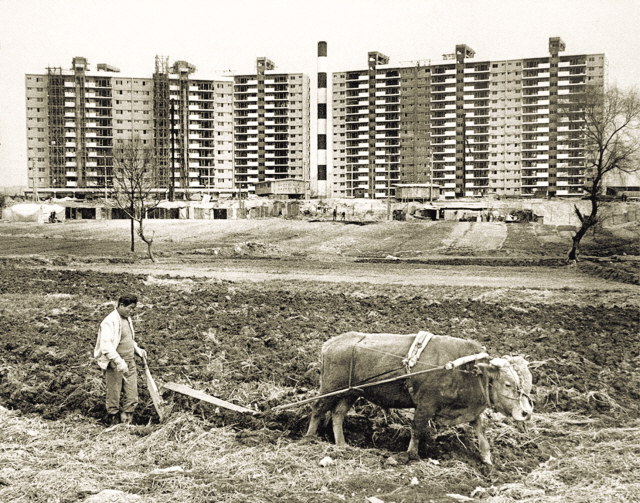Seoul’s changing landscape captured by citizens
Photo exhibition shows Gangnam area when it was nothing but fields
By Korea HeraldPublished : Nov. 14, 2012 - 20:16

Imagine a vast area of farmland in Apgujeong without high-rise buildings. These old scenes of Seoul captured by citizens and photographers will unfold at the Seoul Photo Festival from Nov. 21-Dec. 30.
The third photo festival will showcase photographs taken by professional photographers as well as citizens that offer glimpses into life in old Seoul.
“We try to show memories of Seoul citizens by showcasing as many of their photos as possible, because the photos invite us to take a look at personal history, family history, town history and city history,” said event director Lee Kyung-min at a press conference Tuesday.
Photographs will be grouped into four categories based on what it represents in a certain time period and exhibited at three venues in Seoul, including the Seoul Museum of Art, the principal exhibition venue of the festival, the lobby of the new Seoul City Hall and Seoul Museum of History.
Special exhibitions will be held at the lobby of the new Seoul City Hall, featuring photos with special memories of Seoulites. Children’s photo scrapbooks will be on view at the lobby of the new Seoul City Hall building and Seoul Museum of History.
The festival organizers selected professional photographers who have been living in Seoul and recording the changing landscapes of the city.
Han Jeong-shik, born and raised in Bukchon, a historical neighborhood in northern Seoul, captured ordinary lives of the area, which will remind older people of their childhood.
The third photo festival will showcase photographs taken by professional photographers as well as citizens that offer glimpses into life in old Seoul.
“We try to show memories of Seoul citizens by showcasing as many of their photos as possible, because the photos invite us to take a look at personal history, family history, town history and city history,” said event director Lee Kyung-min at a press conference Tuesday.
Photographs will be grouped into four categories based on what it represents in a certain time period and exhibited at three venues in Seoul, including the Seoul Museum of Art, the principal exhibition venue of the festival, the lobby of the new Seoul City Hall and Seoul Museum of History.
Special exhibitions will be held at the lobby of the new Seoul City Hall, featuring photos with special memories of Seoulites. Children’s photo scrapbooks will be on view at the lobby of the new Seoul City Hall building and Seoul Museum of History.
The festival organizers selected professional photographers who have been living in Seoul and recording the changing landscapes of the city.
Han Jeong-shik, born and raised in Bukchon, a historical neighborhood in northern Seoul, captured ordinary lives of the area, which will remind older people of their childhood.

Jeon Min-jo focused on the development in Gangnam, south of the Han River, and how it changed from what used to be farmland into the city’s busiest business district. One photo shows a field in Apgujeong-dong where a farmer is plowing the field with an ox against the backdrop of newly built high-rise apartments.
Im Seon-yeong’s “Dogok Tower Palace” is the best example of how the farmland was transformed into the wealthiest part of the city, using the luxury apartment building as a symbol of Gangnam’s development.
Photos taken by citizens are on view in chronological order. The dates when they were taken coincide with major historical moments, including the April 19 Revolution in 1960, the North Korean spy raid on the Blue House in 1968, and the summer Olympics in Seoul in 1988.
The exhibition runs from Nov. 21-Dec. 30. Admission is free. For more information, call 070-8240-9902 or visit www.seoulphotofestival.com.
By Lee Woo-young (wylee@heraldcorp.com)
-
Articles by Korea Herald







![[KH Explains] No more 'Michael' at Kakao Games](http://res.heraldm.com/phpwas/restmb_idxmake.php?idx=644&simg=/content/image/2024/04/28/20240428050183_0.jpg&u=20240428180321)




![[Weekender] How DDP emerged as an icon of Seoul](http://res.heraldm.com/phpwas/restmb_idxmake.php?idx=644&simg=/content/image/2024/04/25/20240425050915_0.jpg&u=)






![[Herald Interview] Mistakes turn into blessings in street performance, director says](http://res.heraldm.com/phpwas/restmb_idxmake.php?idx=652&simg=/content/image/2024/04/28/20240428050150_0.jpg&u=20240428174656)
